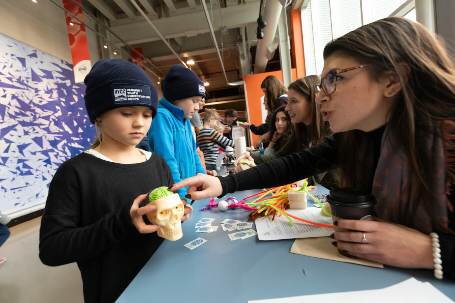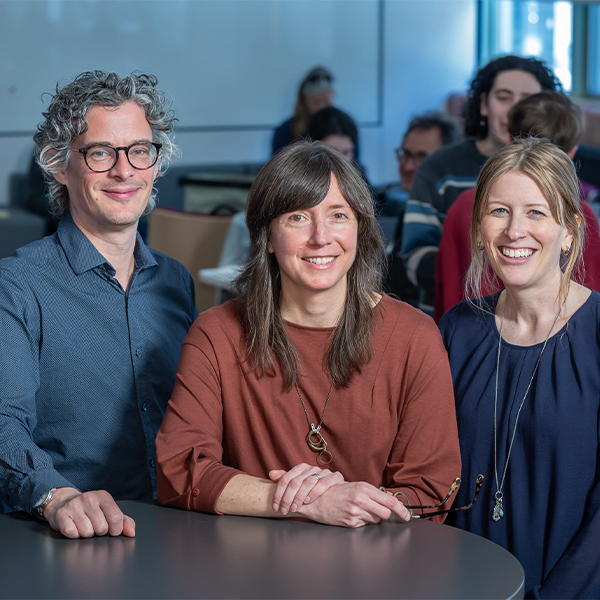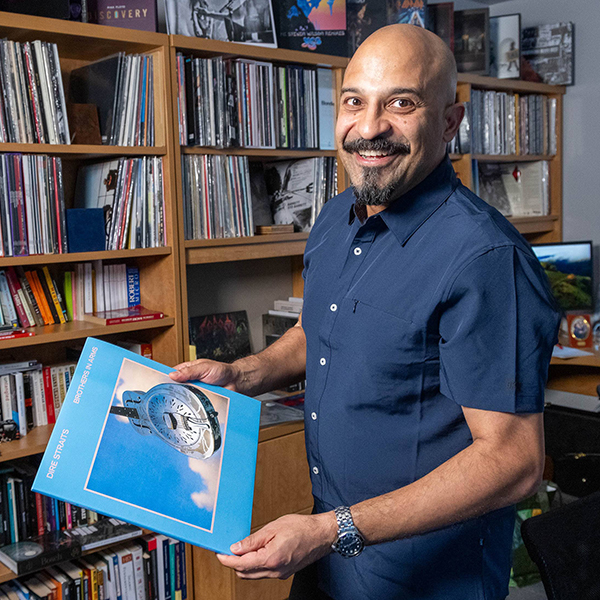Noor Al-Sharif is standing in front of a Montreal classroom, asking a group of grade four students to draw a scientist.
Most of them sketch an Einstein-like character: a man with wild white hair, a lab coat, perhaps a beaker or two. Soon after, when Al-Sharif reveals that she’s a scientist herself, the reaction in the room falls somewhere between awe and disbelief.
“Students don’t often have someone in their classroom who can say something like that,” she says. “It changes their perception of what a scientist can look like.”
Al-Sharif is a doctoral student in McGill’s Integrated Program in Neuroscience and co-president of BrainReach Elementary, which demystifies the brain and brain science. Throughout the academic year, more than 100 BrainReach volunteers bring hour-long neuroscience workshops to elementary and high school classrooms across Montreal.
During initial visits, students might learn about how emotions work, or about the five senses, or neural signals. Later in the year, they learn about the function and anatomy of a calf brain (the rare chance for students to hold an actual brain usually results in a mix of nervous and excited screams).

BrainReach is one of several outreach programs supported by the Faculty of Science (BrainReach is also supported by the Faculty of Medicine). Many of these initiatives aim to make science education more accessible and to spark young people’s excitement around subjects like neuroscience, physics and chemistry. The groups offer bilingual programming for students in kindergarten classrooms, in CEGEPs, and everything in between.
“One of our principles is to use this as an opportunity for our students to develop skills [for reaching out to public audiences],” says Dean of Science Bruce Lennox. “We want this to benefit the people making the presentations, as well as their audiences.”
Even seasoned scientists don’t always do a bang-up job when they talk about the importance of science to lay audiences. “It isn’t an easy thing to do,” says Lennox. “The Joe Schwarczs of the world have developed techniques over the years to do this properly. We tell our students, if you are interested in being involved in outreach, we’re going to help you to be more effective.” And there are plenty of students who are happy to take up that offer. “They eat it up,” says Lennox.
That’s where Jacqueline Farrell, BSc’91, DipEd’95, the faculty’s science outreach program advisor, comes in.
“The way I support [these initiatives] is to really bring the focus of outreach back onto our McGill students. That includes helping to provide science communication training. While a lot of our students have expertise in their research areas, they’ve asked for help with teaching at the K-11 grade level.” Farrell’s position, and the support that she offers to the various outreach groups, are funded by the members of the Faculty of Science Advisory Board. The individual outreach groups also receive funding from other sources, including the different departments within the Faculty, and University Advancement’s Seeds of Change program.
Farrell works closely with Allison Gonsalves, PhD’10, the director of the Faculty of Education’s Science Education Laboratories, and Julianna Zelt, BEd’19, a master’s student in the Department of Integrated Studies in Education, to provide coaching sessions on presenting to younger audiences. Zelt also advises on the outreach programs’ materials and lesson plans, drawing on the latest research in informal science education.
Farrell has has also been collaborating with McGill’s Indigenous education advisor Janelle Kasperski, the University’s Branches Program for Indigenous community outreach, and the Kahnawake Education Center’s Cassidy Meloche, to design workshops that focus on culturally sensitive outreach techniques.
Inquiry-based learning – an approach which places students’ questions, ideas and observations at the centre of the learning experience – is foundational to these sessions. The inquiry method counters traditional teaching approaches that treat science “as something that you just read from a textbook, memorize and make connections about in your head,” says Lisa Dang, BSc’16, a doctoral student in astrophysics and the outreach coordinator for Physics Matters
When Physics Matters visits grade four classrooms with its “Space Explorers” program, each teaching module is framed as a “mission” with a new area of focus – gravity or magnetism, for instance.
Students drop marbles and feathers from great heights, making predictions about whether heavier objects will fall faster or not. Afterwards, they learn about the physical laws that govern their findings.
The Chemistry Outreach Group uses a similar approach. In some of their larger public presentations, the group’s volunteers demonstrate how to (safely) make liquid nitrogen ice cream or combust hydrogen-filled balloons. The Chemistry Outreach Group also travels to different schools, working with the schoolteachers there to tailor their presentations to reflect what’s being taught in the classrooms.
Simplicity and accessibility are key factors for a successful outreach experience. “We try to make our material relate to students’ everyday lives so it doesn’t seem completely abstract,” says BrainReach High School co-president Alexia Ostrolenk, a PhD candidate at the Université de Montréal and a research lab coordinator at McGill’s Perceptual Neuroscience Laboratory for Autism and Development.
“Things that could be covered by neuroscience range from how a musician can coordinate their movements, to why some people are disabled because of how their brain develops, to what we can do with artificial intelligence,” says Ostrolenk.
For secondary students, BrainReach volunteers also facilitate discussions on mental health, explaining the neural basis of disorders like depression and anxiety. While the group primarily visits public schools in under-resourced neighbourhoods throughout the city, BrainReach North organizes trips and teaching materials to assist educators working in remote and Indigenous communities in northern Quebec.
The outreach programs aren’t confined to classrooms, either. Astro McGill, the education and public outreach program associated with the McGill Space Institute, organizes a popular lecture series that focuses on the wonders of the universe.
Several of the Faculty’s outreach programs have been active at community events like the Eureka Science Festival and 24 heures de science. Last year, youth programming and public presentations by student-led outreach groups supported by the Faculty reached almost 18,000 people.
Establishing these relationships with the public is especially important at a time when Canadians’ trust in scientists seems to be eroding. A recent poll from Ipsos and 3M found that half of the Canadians surveyed believe scientists are “elitist.”
“Being able to meet scientists humanizes them in some way,” says Dang. “We just try to be ourselves instead of acting like strict or emotionless scientists. Making a human connection and letting people know that we’re not so different from them is a way we can gain trust from the public.”
Public education is also crucial for fighting scientific misinformation, notes Alexander Wahba, BSc’02, PhD’10, an academic associate in the Department of Chemistry and the staff supervisor for the Chemistry Outreach Group. In sessions with both children and adults, members of the group dispel myths – the notion that all chemicals are bad, for instance.
And if some of the young students the outreach volunteers encounter start to imagine a career in science for themselves, all the better. “We try to show young people that scientists come in all shapes and colours, that we don’t all wear lab coats and most importantly, that science is not magic,” says Eviatar Fields, a PhD student in neuroscience and BrainReach High School’s co-president. “Anyone can do science; it isn’t this higher power, but a way of thinking that they already use every day.”
That approach seems to be working – at least by one measure. After a few regular visits to a classroom, BrainReach volunteers ask students to draw a scientist once again. The activity yields very different results the second time around: students often draw themselves.
Image in article: McGill’s BrainReach program recently took part in educational outreach
activities at the Montreal Science Centre (Photo: Owen Egan)


